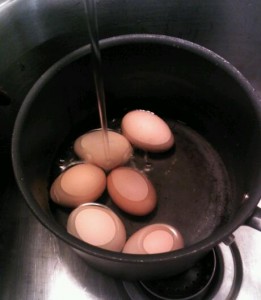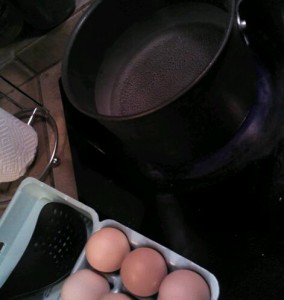There have got to be several dozens of sets of instructions online regarding egg boiling, and I’ve run across several folks convinced that they don’t do it well. It’s true it can be tricky, and the “right” way to do it may well vary depending on your climate, altitude, and other factors.
I’m certainly no expert on the subject. But I want to catalog my current methods for boiling eggs. One is a cooking method for storebought eggs that – for me – has been fairly foolproof so far in a number of different climates. I might get a bit of the dreaded gray ring around the yolk, but not enough to affect the flavor that I’ve noticed. The other method is for when I’m lucky enough to have yard eggs… and I have only tested this here in coastal Louisiana.
NOTE ON STORING EGGS: First, know whether your eggs have been washed or not. Storebought eggs are washed; yard eggs from a neighbor likely won’t be. Washing removes a waxy protective layer that was originally on the egg; unwashed eggs have more protection from invading bacteria and will be safer to eat for longer. If you have some yard eggs on your hands that haven’t ever seen the inside of a fridge, and haven’t been washed, they can be kept at room temperatures for up to several weeks. When eggs are exposed to refrigerator temperatures, then a membrane inside the egg has likely shrunk and separated from the shell, making it easier for bacteria to enter the egg, and making room temperature dangerous for that egg’s future as food. If an egg is store bought, it’s already been washed and refrigerated, and needs to be kept in the fridge for the remainder of its storage life.

Hard Boiling Storebought Eggs
Eggs you’d like to boil
pot big enough to hold them covered in at least 1-2 inches of water1. Put eggs on medium high heat, and allow to boil. You want a solid boil without it being overly vigorous.
2. Once boiling, set a timer for 20 minutes.
3. When 20 minutes are done, remove eggs from heat and pour out as much of the water as you comfortably can without throwing the (hot) eggs out of the pot. Refill pot with cold water. This refill is for cooling off the pot — pour it out and refill a second time with cold water. Let set for a few minutes.Eggs are ready to be peeled or refrigerated.
A NOTE ON PEELING BOILED EGGS: Leaving any eggs in cold (or even ice) water helps make them easier to peel. You can leave them whole, or if you’re using them soon you can go ahead and crack them. Some folks swear by adding salt to the water for the same reason. Whatever you do, be aware that there’s a membrane just inside the egg; take a minute to notice it next time you peel an egg, if you haven’t before. If you can hook your thumb under that membrane, and pull shell and membrane off together, you’ll have a much easier time peeling than you will if you’re trying to remove shell from membrane. Fresher eggs have a membrane that’s more attached, unfortunately, so they might be harder to peel. If you’ve got super-fresh eggs, remember the cold/ice water tip.
Hard Boiling Fresh/Yard Eggs
Eggs you’d like to boil
pot big enough to hold them covered in at least 1-2 inches of water
Slotted spoon1. Put pot on medium high heat with enough water to eventually cover eggs. Keep eggs to the side for now.
2. When water is boiling (you want a solid boil without it being overly vigorous), use slotted spoon to carefully lower eggs into the water.
3. Set a timer for 15 minutes.
4. When 15 minutes are done, remove eggs from heat and pour out as much of the water as you comfortably can without throwing the (hot) eggs out of the pot. Refill pot with cold water. This refill is for cooling off the pot — pour it out and refill a second time with cold water. Let set for a few minutes.Eggs are ready to be peeled or refrigerated.

Leave a Reply